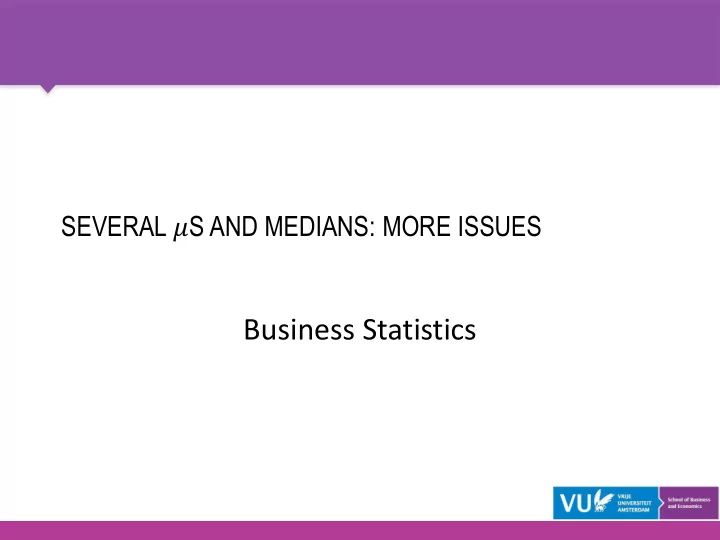

SEVERAL 𝜈 S AND MEDIANS: MORE ISSUES Business Statistics
CONTENTS Post-hoc analysis ANOVA for 2 groups The equal variances assumption The Kruskal-Wallis test Old exam question Further study
POST-HOC ANALYSIS After rejecting the null hypothesis of equal means, we naturally want to know: ▪ which of the means differ (differs) significantly? ▪ is it (are they) lower or higher than the others? We are only allowed to go into this after 𝐼 0 has been rejected ▪ therefore, we speak of a post-hoc analysis or post-hoc test 𝑑 𝑑−1 For 𝑑 groups, there are distinct pairs of means to be 2 compared ▪ so-called multiple comparison tests
POST-HOC ANALYSIS There are many such multiple comparison tests We focus on Tukey’s studentized range test (or HSD for “honestly significant difference” test) ▪ a multiple comparison test that is widely used ▪ named after statistician John Wilder Tukey (1915-2000)
POST-HOC ANALYSIS This line, for instance, compares Club 1 to Club 3
POST-HOC ANALYSIS On the basis of significant differences, SPSS defines homogeneous subsets The means of club 2 and club 3 cannot be discerned (statistically), and both differ significantly from the mean of club 1. And: club 1 is significantly better. Rule: if two groups are in the same subset, they do not differ significantly
ANOVA FOR 2 GROUPS Comparing 2 means ▪ Choice between: ▪ independent sample 𝑢 -test ▪ ANOVA ▪ Example on Computer Anxiety Rating
ANOVA FOR 2 GROUPS Result of 𝑢 -test (which of the two?) Result of ANOVA
ANOVA FOR 2 GROUPS Comparing two means (equality: 𝜈 1 = 𝜈 2 ) ▪ 𝑢 -test ▪ null distribution: 𝑢~𝑢 𝑜 1 +𝑜 2 −2 ▪ reject for small and large values ▪ equal variance required ▪ or the other test without this requirement ▪ normal populations required ▪ or symmetric populations and 𝑜 1 , 𝑜 2 ≥ 15 , or 𝑜 1 , 𝑜 2 ≥ 30 ▪ ANOVA for two groups (one factor with two levels) ▪ null distribution 𝐺~𝐺 1,𝑜 1 +𝑜 2 −2 ▪ reject for large values ▪ equal variance required ▪ normal populations required
ANOVA FOR 2 GROUPS So, 𝑢 -test is not superfluous now we have ANOVA You still need the independent samples 𝑢 -test: ▪ more hypotheses possible ( 𝜈 1 ≥ 𝜈 2 , 𝜈 1 = 𝜈 2 + 7 , etc.) ▪ weaker requirement for population variances ▪ weaker requirement for population distributions
THE EQUAL VARIANCES ASSUMPTION Main assumption of ANOVA: equal variances Seen before in the independent samples 𝑢 -test 2 = 𝜏 2 ▪ where the pooled variance was used to estimate 𝜏 1 2 the assumption was tested with Levene’s test
THE EQUAL VARIANCES ASSUMPTION Levene’s test is a homogeneity of variance test 2 = 𝜏 2 2 ) ▪ works for two variances ( H 0 : 𝜏 1 2 = 𝜏 2 2 = 𝜏 3 2 = ⋯ ) ▪ but also for several variances ( H 0 : 𝜏 1 Example (golf clubs) ▪ 𝑞−value ≫ 0.1 , so hypothesis of equal variances is not rejected if not, escape to nonparametric ANOVA? ▪ validity of use of ANOVA is OK see next ...
THE KRUSKAL-WALLIS TEST ▪ Recall that we used non-parametric methods when populations are not normally distributed ▪ Can we develop a non-parametric ANOVA? ▪ Yes: the Kruskal-Wallis test ▪ based on ranking of the observations on 𝑍 ▪ compares medians ( 𝐼 0 : 𝑁 1 = 𝑁 2 = 𝑁 3 = ⋯ ) ▪ has lower power than ANOVA (is less sensitive) ▪ requires few assumptions ▪ Generalization of Wilcoxon-Mann-Whitney test, but for more than two groups
THE KRUSKAL-WALLIS TEST Computational steps in Kruskal-Wallis test: ▪ Rank the observations 𝑧 1 , … , 𝑧 𝑜 , yielding 𝑠 1 , … , 𝑠 𝑜 𝑑 ▪ 𝑜 𝑘 size of group 𝑘 ; 𝑜 = σ 𝑘=1 𝑜 𝑘 ▪ Calculate the sum of ranks in every group 𝑜 𝑘 𝑆 𝑗𝑘 (for all groups 𝑘 = 1, … , 𝑑 ) On formula sheet a ▪ 𝑈 𝑘 = σ 𝑗=1 slightly different form ▪ Calculate test statistic that works easier 2 ; reject for large values 12 𝑑 𝑜 𝑘 𝑈 ∙𝑘 − ന ▪ 𝑜 𝑜+1 σ 𝑘=1 𝐼 = 𝑈 ∙∙ 2 ▪ Under 𝐼 0 : 𝐼 ∼ 𝜓 𝑑−1 Required: populations of “similar” shape ▪ test right-tailed (like ANOVA) ▪ for very small samples (groups<5), test not appropriate
THE KRUSKAL-WALLIS TEST Example: comparing three golf clubs ▪ using SPSS Kruskal-Wallis statistic ( 𝐼 ) 𝑞 -value
EXERCISE 1 Fill out the table
OLD EXAM QUESTION 21 May 2015, Q1n
FURTHER STUDY Doane & Seward 5/E 11.3-11.4, 16.5 Tutorial exercises week 4 Homogeneous subsets, Kruskal-Wallis test
Recommend
More recommend